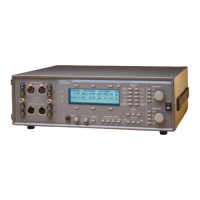Status Bits
The digital status bits do not have their own measurement function.
They are displayed on the Status Bits Panel, which is selected by
several presses on the INSTRUMENT MODE PANELS key.
The perimeter of the display and the soft keys are used to control the
outgoing status bits. The center section of the display shows the
incoming status bits.
The upper left section of the display shows the Consumer/Professional
mode bit. Since the status bits are allocated differently for the two
modes, the state of this bit changes the other available selections. The
AES/EBU standard (usually balanced) defines Professional mode,
although Consumer mode is sometimes used. The SPDIF-EIAJ
standard (usually unbalanced) defines Consumer mode.
The upper center section displays the Pre-emphasis indicator bit. This
bit can indicate 15/50 µs pre-emphasis, CCITT J17 pre-emphasis, that
there is no pre-emphasis, or that the emphasis is not indicated.
The upper right section displays the bits that indicate the sample rate
of the data. Sample rates of 48 kHz, 32 kHz, and 44.1 kHz are
available. If the reference source on the Digital I/O panel is set to
STAT, then it is from these bits that the instrument will read the
reference rate for calculating the frequency of incoming digital audio
signals.
The lower area of the display changes depending on the
Consumer/Professional mode. In Consumer mode, this displays the
Copyright flag. This status bit provides copy protection to the
program material. It has two states: copy permitted (OK) and copy
prohibited (NO). In Professional mode, this area displays the signal’s
origin, if the origin is encoded in the status bits. The origin is generally
a text string.
Figure 4-43. Status Bits panel
& For more
information on
setting the Status
Bits, see page 3-20.
& For more
information on the
Reference Source
on the Digital I/O
Panel, see page
4-43.
4 Functions
Status Bits Function Descriptions
4-48 ATS-1 Dual Domain User's Manual

